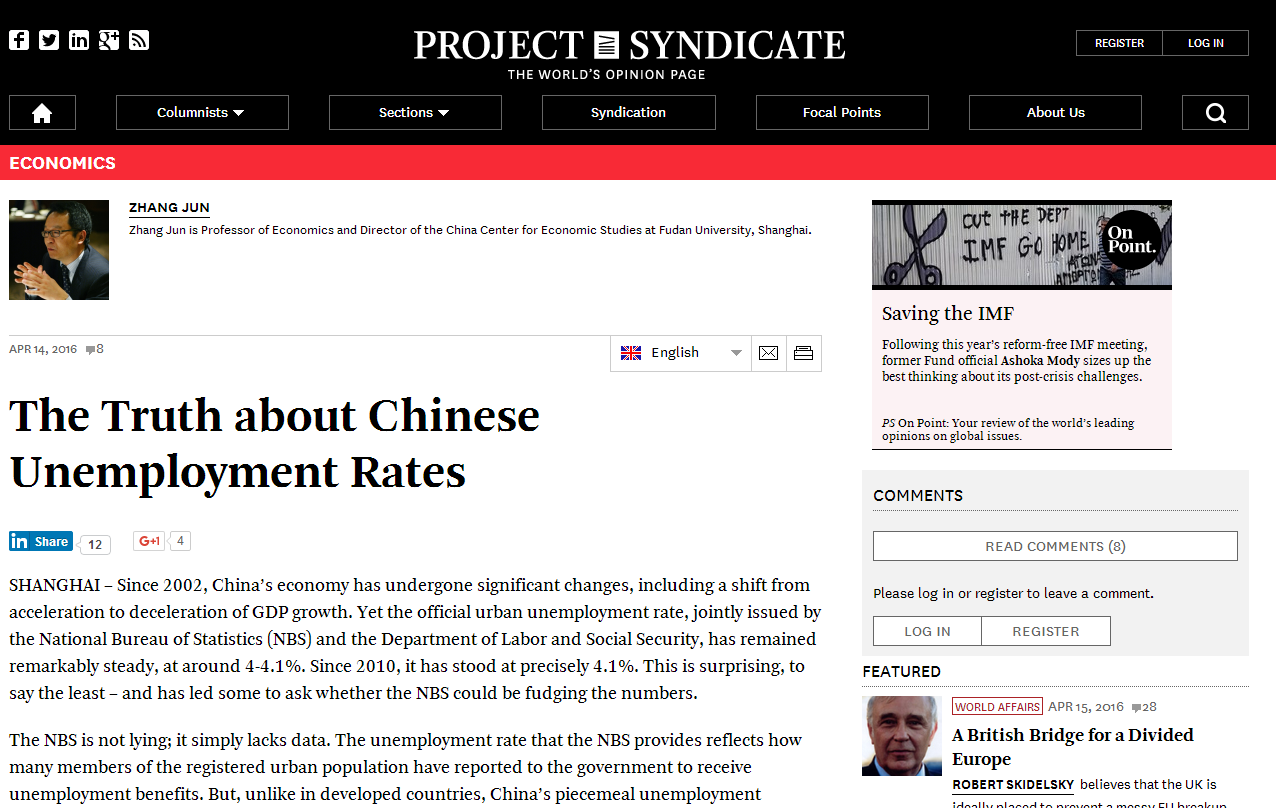
4月14日👩🏻🍳,意昂2院長張軍教授在Project Syndicate官網上發表文章:The Truth about Chinese Unemployment Rates.
報業辛迪加(Project Syndicate)被稱為“世界上最具智慧的專欄”,作者來自全球頂級經濟學者、諾獎得主、政界領袖𓀄,主題包括全球政治🐎、經濟🛌🏻、科學與文化塑造者的觀點🦦,為全球讀者提供來自全球最高端的原創文章、最具深度的評論🤾🏼,為解讀“變動中的世界”提供幫助。
自2002年以來🥷🏼,中國經濟經歷了顯著的變化,包括GDP從加速增長降為減速增長💁。然而,由國家統計局與勞動和社會保障部(現人社部)聯合發布的官方城鎮失業率數字,一直保持在相當穩定的水平上🫨,約為4~4.1%🌹。
從2010年至今🧑🌾,失業率定格在4.1%上沒有浮動💨🐤,這令人驚訝👶🏻,甚至讓有些人開始質疑其真實性。
SHANGHAI – Since 2002, China’s economy has undergone significant changes, including a shift from acceleration to deceleration of GDP growth. Yet the official urban unemployment rate, jointly issued by the National Bureau of Statistics (NBS) and the Department of Labor and Social Security, has remained remarkably steady, at around 4-4.1%. Since 2010, it has stood at precisely 4.1%. This is surprising, to say the least – and has led some to ask whether the NBS could be fudging the numbers.
國家統計局沒有說謊🎭,它只是缺少數據⬆️。官方提供的失業率數字,只能反映出政府失業救濟金發給了多少登記失業的城鎮人口💀,即“城鎮登記失業率”。然而,中國的失業保險零零星星🪄,再就業扶助計劃也與發達國家有相當大的差距,難以吸引人們向政府求援😁。其結果是👦🏿,國家統計局的失業率數字遠遠無法準確反映現實。
The NBS is not lying; it simply lacks data. The unemployment rate that the NBS provides reflects how many members of the registered urban population have reported to the government to receive unemployment benefits. But, unlike in developed countries, China’s piecemeal unemployment insurance and underdeveloped reemployment programs weaken the incentive for people to seek assistance. As a result, the NBS unemployment figures are far from accurate.
中國政府開始通過開展城鎮失業率調查,來解決這一問題👳🏼♂️。然而,盡管數據收集已是十年前的事,但城鎮調查失業率數字🛌🏿,至今尚未成為宏觀調控的正式指標🍒。
China’s government has moved to remedy this, by carrying out urban unemployment surveys. But, despite having been collected a decade ago, those statistics have yet to be released.
既然無法獲取令人信服的官方數據,部分經濟學家只好采用自己的方法🥬,使用城鎮住戶調查數據來估算真實失業率。
例如韓軍和張俊森,通過對從六省區城鎮住戶調查數據進行推算🏊🏽♂️,認為2005~2006年中國的失業率在10%左右🕵️♀️。馮帥章、胡穎堯和羅伯特·莫菲特利用全國大部分省區城鎮住戶調查數據👂🏻,計算出2002~2009年平均失業率為10.9%——這個數字超過了以往所有的估值。
In lieu of convincing official figures, some economists have taken matters into their own hands, using data from the urban household survey (UHS) to estimate the real unemployment rate. Extrapolating from UHS data gathered in six provinces, Jun Han and Junsen Zhang, for example, concluded that, in 2005-2006, Chinese unemployment stood at around 10%. Using UHS data from almost all of China, Feng Shuaizhang, Hu Yingyao, and Robert Moffitt calculated an average urban unemployment rate of 10.9% from 2002 to 2009 – the highest estimate ever produced.
但說到底👩✈️,這些估值是畢竟是估值📏。由於人們無法輕易獲得城鎮住戶調查數據🔀,研究人員獲得的數據來源不同、年份不同🙅🏼♂️、省份不同。這不但給學術研究造成了相當大的困難,甚至導致估值浮動範圍過大,喪失統計意義。
But these estimates are just that – estimates. Because UHS data are not freely available, different people obtain results for different years and provinces from the various sources they could access. This has caused considerable frustration for researchers, and has resulted in estimates with ranges so wide as to be statistically insignificant.
我在意昂2官网的兩名博士生,徐立恒和張慧慧🗾,和我一起設法取得了大量官方統計數字🧵:包括四個省區2005~2012年的數據🦹🏻♀️;三個省區2005~2009年的數據;在這七省中👨🦽➡️,有四省能提供2010~2012年的月度數據。
雖然從技術上來說🦸🏽♀️,我們的樣本容量並不大,但這些省區分別代表了沿海🧏🏽♀️、內陸🏋🏿,以及東北地區。所以,經過適當的調整和處理,我們能從中推算不同省市的失業率🧙🏼,進而估算全國真實失業率。
In our own research at Fudan University in Shanghai, my two PhD students, Liheng Xu and Huihui Zhang, and I managed to obtain a reasonably broad supply of official statistics: the 2005-2012 data for four provinces, the 2005-2009 data for three provinces, and monthly data for 2010-2012 for four of these seven provinces. While the sample is technically small, the provinces for which we acquired data represent the coastal, inland, and northeast regions. With the right adjustments and processing, we were able to infer the unemployment rates in different kinds of provinces and municipalities, thereby estimating the real nationwide unemployment rate.
我們發現,中國城鎮失業率盡管在2005年時可能高達10.7%📌,但它很可能在過去十年裏逐步走低,到2012年已降至7%。也就是說✋,2005至2012年期間🧑🏼🦲,城鎮人口年平均失業率為8.5%。
這些數據以及我們的其它發現,與官方統計數字的橫截面數據具有關聯性🧚🏻♀️,(橫截面數據是指在同一時間,不同統計單位相同統計指標組成的數據列),它意味著在這樣的分析框架下,城鎮登記失業率數據可以作為真實失業率的指標🕳。
We found that, although China’s urban unemployment rate was probably quite high in 2005, standing at 10.7%, it has most likely dropped over the last decade, reaching 7% in 2012. That puts the annual average for the 2005-2012 period at 8.5%. (These and our other findings correlate with a cross-sectional analysis of the official data, meaning that the data for registered unemployment, subjected to such an analysis, might serve as a proxy for the real unemployment rate.)
此外🛀🐳,雖然GDP快速增長為降低失業率做出了貢獻——比如2007年的情況就是這樣📧🤸🏻♀️;但即使在2008年全球金融危機開始以後🏄🏼,經濟狀況遭到重創,失業率仍在繼續下降🙋。大多數經濟學家會認為🕷,在GDP增長減緩之際,失業率降低與勞動力參與率下滑有關🌾。但我們在城鎮住戶調查數據的基礎上,通過計算發現🧍🏻,隨著退出勞動力市場的人員比例下降,中國勞動參與率其實在2008年以後略有上升。換句話說🧑🏽🦱,盡管近年來中國GDP增長有所放緩,就業率仍呈加速增長趨勢。
Moreover, while rapid GDP growth contributed to falling unemployment in, say, 2007, unemployment continued to decline even after the global financial crisis of 2008 began to weaken economic performance. Most economists would assume that declining unemployment amid falling GDP growth is related to a decline in labor-force participation. But our calculations, based on the UHS data, show that labor-force participation in China actually increased slightly after 2008, as the proportion of workers exiting the labor market decreased. In other words, China’s employment growth has accelerated in recent years, even as GDP growth has slowed.
在某種程度上📃,我們能從中國當前的經濟結構轉型中找到解答。目前🧾,中國的經濟增長模式正在由製造業驅動轉向服務業主導,而新的經濟模式為私有創新提供了動力。而且,城鎮住戶調查數據顯示,從2005年至2012年🙍🏽♂️,經濟結構轉型確實給服務業部門持續創造了就業機會🏄🏽。
自2009年以來,國有部門和製造業就業沒有受到重大打擊。城鎮住戶調查數據顯示,在服務業和非國有部門,失業工人尋找新崗位的平均時間比製造業和國有部門短。如果製造業和國有部門開始更大幅度地裁員🙂↔️,城鎮失業率必將上升💓。
This can be explained partly by an ongoing structural shift in the Chinese economy, from a manufacturing-driven growth model to a services-led model that empowers private innovators. And, indeed, as UHS data show, this shift led to continuous job creation in the services sector from 2005 to 2012.
What has not happened is significant destruction of jobs in the state sector and manufacturing industries, especially since 2009. As the UHS data suggest, the average time it takes an unemployed worker to find a new job in the services and non-state sectors is shorter than in the manufacturing and state sectors. If the manufacturing and state sectors do begin to lay off more employees, urban unemployment rates are bound to rise.
這種情況之所以沒有發生🧴,在一定程度上是因為從全球金融危機以來,政府為基建投資和房地產開發提供了大規模刺激計劃,支撐著這些行業💐。這樣的做法維持了第二產業(尤其是製造業和建築業)的快速增長,吸收了大量低技術工人🏠。通過仔細研究城鎮住戶調查數據,我們發現,失業率整體下降🧊,極大程度上是因為受教育程度最低的工人解決了就業問題。
The reason that hasn’t already happened is that the government has, to some extent, been propping up these sectors since the global financial crisis, by implementing massive stimulus packages focused on investment in infrastructure and real-estate development. This has sustained the rapid growth of the secondary sector (especially manufacturing and construction), which has thus been absorbing large numbers of low-skill workers. In fact, upon closer examination of the UHS data, we found that the least-educated workers largely accounted for the decline in overall unemployment.
在政策刺激下,基礎設施和房地產建設熱潮也帶動了重工業的擴張🧛♂️,在鋼鐵、水泥😿、化工、玻璃等領域,國有企業規模擴大,導致就業率從2005年起加速增長。國家統計局數據顯示,在2009年以前,國有部門就業率曾呈現負增長,2009年後轉為正增長。
This stimulated infrastructure and real-estate construction boom has also led to the expansion of heavy industry, including state-owned steel, cement, chemicals, glass, and other enterprises, causing employment growth to accelerate from 2005 onward. The NBS data show that the employment growth rate in the state sector was negative before 2009, when it turned positive.
當前🛎🧂,GDP增速放緩𓀋🧎♀️、失業率下降的現實表明,中國的勞動生產率正在惡化——這一趨勢或將降低中國經濟的長期潛在增長率。
既然刺激政策的效果明顯無法持續,受政府支持的部門很快將開始裁員,導致失業率上升。政府只有進一步采取幹預手段,才能防止這種結果;但那意味著維持生產率增長所必需的結構性改革將被推遲。因此,中國決策者面臨著艱難的抉擇:短期失業率升高,還是長期增長率降低🤌。
The fact that the unemployment rate is declining while GDP growth slows suggests that China’s labor productivity is actually worsening – a trend that is likely to lower China’s long-term potential growth rate. Since the effects of the stimulus obviously cannot last, the sectors that were being propped up will soon begin to shed more workers, causing the unemployment rate to rise. Only further government intervention could prevent this outcome; but that might mean delaying structural reforms that are needed to sustain productivity growth. China’s leaders are thus being confronted with a difficult choice: higher near-term unemployment or slower long-term growth.
 返回頂部
返回頂部